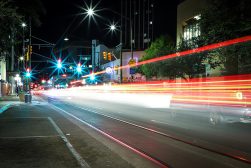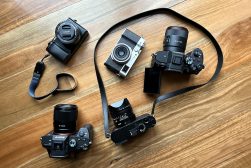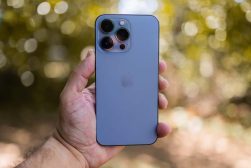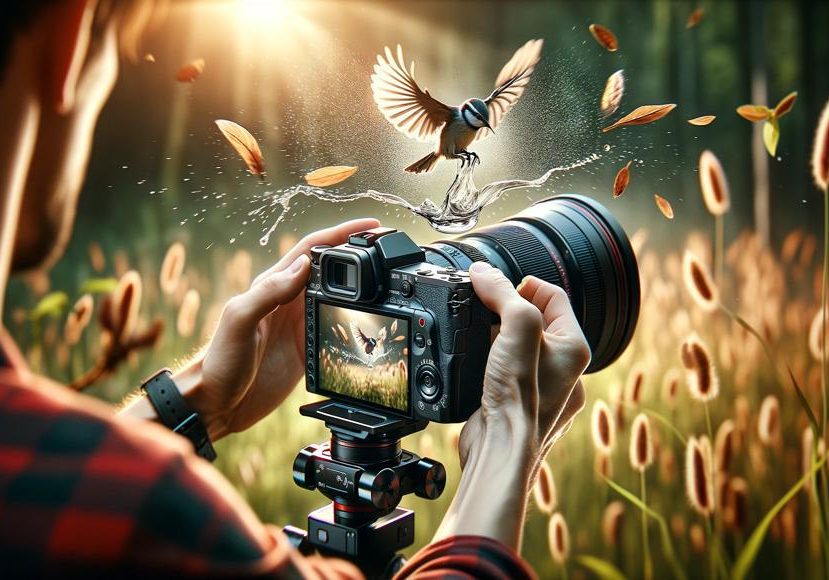
Best Slow Motion Cameras in 2024 (All Budgets)
Discover the best cameras for shooting slow motion footage, from the top mirrorless, DSLR or action cam through to specialized gear.
Shotkit may earn a commission on affiliate links. Learn more.
This guide will take you through some of the best slow-motion cameras on the market today.
Many of today’s cameras have not only great video-making features but also the ability to capture slow-motion footage.
That gives you the opportunity to get creative and to show things in even more detail than before.
But, as always, with so many options out there, it can be hard to make the choice that’s best for your needs.
This article will introduce you to some of the best slow-motion cameras, and also take you through how to best make that slow-motion footage.
What is the Best Slow Motion Camera in 2024?
Panasonic Lumix GH6 (Best Slow Motion Mirrorless Camera)
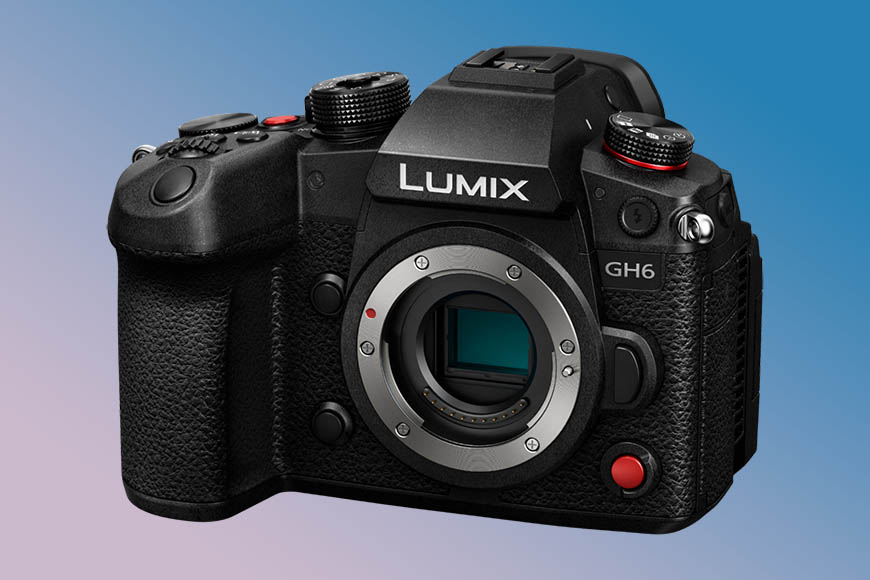
- 4K at 120 fps
- Good value for money
- Fast sensor readout
- Image stabilization
- Good autofocus
- Some of the V-logs can be noisy
The Panasonic Lumix GH6 is a pioneering micro-four-thirds camera that’s packed with video options.
It also comes at a reasonable price, at around US$2000, which represents the most affordable entry point to high-quality, pro-level video recording of all speeds.
It has a high-resolution 25-megapixel sensor that has the capacity to record 5.7K video footage and 10-bit color 4K 120 fps slow-motion video to an SD card.
It has an incredibly fast sensor readout, which is more than capable of handling speeds of up to 300 fps (which the camera can do in Full HD mode), and avoids any rolling shutter.
It uses V-logs and Hybrid logs for the recording, so there’s plenty of latitude for post-production, and the GH6 has unlimited recording time thanks to its sophisticated cooling system that funnels heat away from the sensor.
There’s in-body image stabilization and great autofocus – not quite as good as Sony’s, but still very reliable and fast.
That system has subject-tracking autofocus, which, like the Sony, recognizes people and animals and switches from body to eye tracking as the subject gets closer, or the other way around if they get further away.
All in all, it’s a great camera that allows you to shoot smooth slow-motion footage.
- Read more: Best Cameras for Vlogging
Sony Alpha 7S III (Best Low-Light Slow Motion Mirrorless Camera)
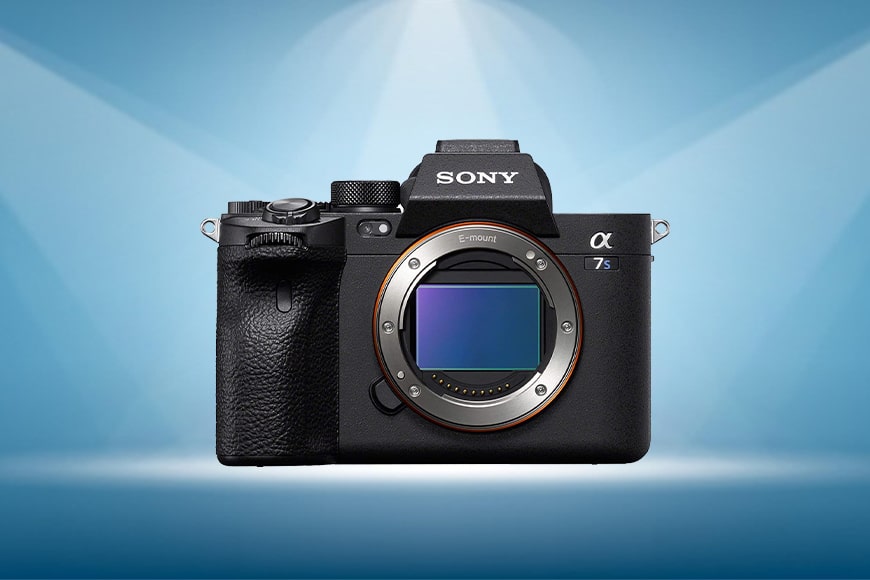
- 4K at 120 fps
- World-beating autofocus
- Great low-light performance
- Image stabilization
- Full-frame sensor
- Extremely expensive
- Lower resolution
The Sony Alpha 7S III is one of the best slow-motion cameras, coming in close second to the GH6.
It has a lower resolution than the GH6 and is far more expensive, but still, a lot of people are crowing over this camera, and for good reason.
Its 12.1-megapixel full-frame sensor outperforms the GH6 in low light because it is full-frame (compared to the GH6’s micro-four-thirds) and because it’s optimized for low light.
The Sony Alpha 7S III can record 4K video recording at up to 120fps and Full HD at up to 240fps. That is high-resolution slow-motion footage.
The A7S III boasts impressive bitrates for video recording, with up to 600 Mbps in 4K.
Also, it supports 10-bit color, enabling rich color when recording and more flexibility in post-production.
There are also high-end recording options. Alongside Sony’s S-Logs, the camera incorporates S-Cinetone, which is found on Sony’s pro-Cinema Line of cameras and gives users cinema-grade colors.
Despite being a pro-level piece of gear, it’s also user-friendly. Its vari-angle touchscreen makes it easy to shoot from tight angles and adjust settings.
It has 5-axis in-body image stabilization to ensure steady footage and, one of the most important features for anyone shooting slow-motion video, incredible autofocus.
Sony’s Fast Hybrid AF system has 759 phase-detection points and 425 contrast-detection areas. It’s amazingly fast and accurate, even during slow-motion recording.
There’s even real-time eye-tracking autofocus for both humans and animals.
- Check out our review of the Sony A7S III.
Canon EOS 90D (Best Slow Motion DSLR Camera)
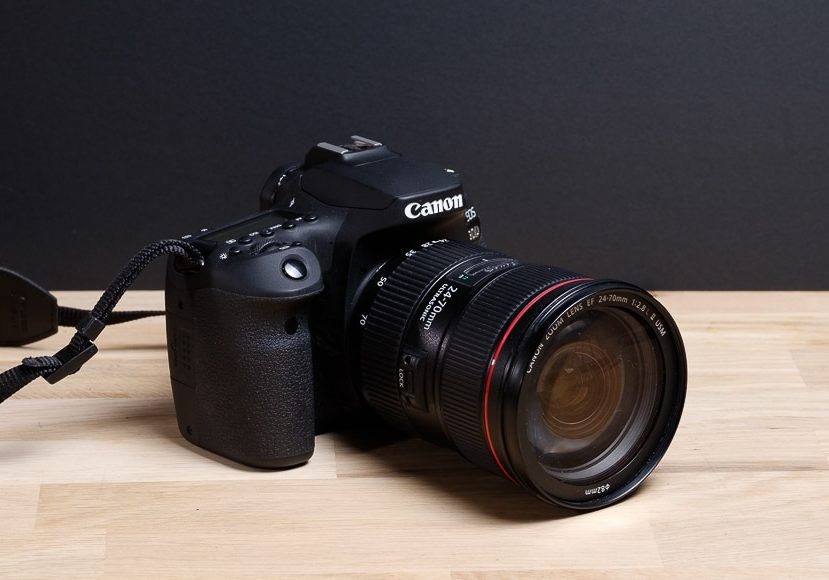
Credit: Greg Cromie
- User-friendly
- Affordable
- Excellent video quality
- Great autofocus
- Articulating touchscreen
- Cropped sensor
- Not the best low-light performance
The 90D features a high-resolution 32.5 megapixel APS-C sensor, which produces excellent video quality, with the true-to-life colors Canon is known for.
However, as it’s a cropped sensor, you don’t get the best low-light performance, which is something to bear in mind.
If you need to shoot in low light, you’ll need to bump up to something like the Nikon D780 [Amazon | B&H], which is a full-frame camera. It has a lower resolution and fewer video options than the Canon 90D, but better low-light performance.
It’s also more expensive, and this Canon is very good value at just a shade over $1000.
It has Canon’s DIGIC 8 processor, so it’s able to comfortably handle any kind of video recording you throw at it.
And you can record at 30 fps in 4K, although with a 1.6x crop factor.
For the slow-motion people (who are our people right now), the 90D offers Full HD (1080p) video recording at 120fps.
That’s nice and slow, and you’ll get buttery smooth footage from that frame rate.
The camera has Canon’s Dual Pixel CMOS AF autofocus system, which provides fast and accurate autofocus.
Plus, the camera’s articulating touchscreen makes it easy to compose your slow-motion footage from interesting angles and also navigate the menu to adjust settings.
Those menus, as they generally are with Canon, are very user-friendly.
- Read our full review of the Canon EOS 90D.
Sony Cyber‑Shot RX10 IV (Best Slow Motion Bridge Camera)
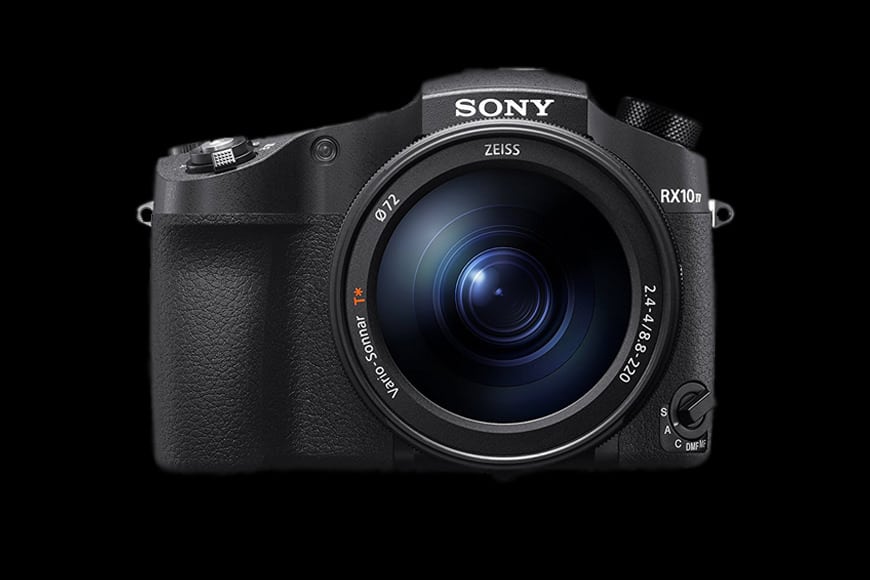
- Good value for money
- Image stabilisation
- High-quality images
- Good slow-motion capabilities
- Great autofocus
- Not the best in low light
- Poor battery life
- Fixed lens may be limiting for some
This Sony is a bridge between consumer-level and pro-level equipment.
It’s compact, and convenient in that it comes as a whole package (no interchangeable lens system here), but still packs in some great features.
And given the high quality of its features, it could compete with quite a few higher-end cameras.
Its build quality is excellent. It is rugged and ergonomic, and the magnesium alloy body looks and feels like a DSLR in use.
It has a 24-600mm zoom lens, with a variable aperture of f/2.4-4. That’s pretty good! Although a variable aperture isn’t ideal, it’s a small range, and f/4 at 600mm is impressive.
It has built-in image stabilization and, as you’d expect from Sony, it has incredible autofocus, especially in the tracking modes. This model has exactly the same system as the Sony A9, which is a 5000-dollar camera.
The highest resolution recording is done with super-sampled 4K for extra detail, and users can record footage using different S-Logs for added post-production flexibility.
While you don’t get the possibility of shooting slow motion in 4K, you can get super-slow-motion in Full HD; a frame rate of 120 fps.
There’s also a dedicated High Frame Rate (HFR) mode which boosts the camera up to 960 fps, which is getting into the realm of specialized slow-motion equipment specs.
- Read more: Best Bridge Cameras
Sony ZV-1 (Best Point-and-Shoot Camera for Slow Motion)
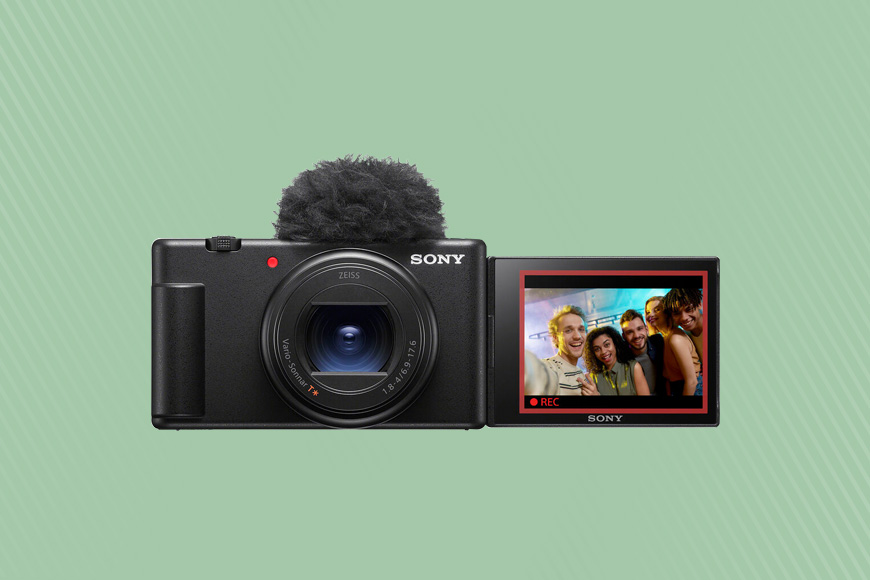
- Good value
- Fits in your pocket
- Excellent lens
- Outstanding autofocus
- Built-in ND filter
- No slow-motion 4K
Primarily designed for vloggers and other content creators, this camera has impressive slow-motion capabilities for such a compact device.
At under US$800, it also won’t break the bank.
It produces high-quality images and footage, thanks to its 20.1-megapixel sensor and a ZEISS 24-70mm f/1.8-2.8 lens.
It has a user-friendly interface with a side-articulating touchscreen, from where you can easily control your settings, switch modes, and navigate the menu.
Like the Cybershot above, the ZV-1 cannot film slow-motion in 4K, but its standard speed footage is super-sampled 4K and, as such, very high quality.
You do get Full HD (1080p) slow-motion recording at 120fps, though, which produces smooth and detailed slow-motion playback.
Some nice touches for the video makers are built-in image stabilization and the built-in Neutral Density (ND) filter.
The former helps you get non-shaky footage, and the latter helps control exposure, especially when shooting outdoors in bright conditions.
Using the ND filter feature will allow you to use the lower shutter speeds necessary for creating effective slow-motion footage.
GoPro Hero12 Black (Best Action Camera for Slow Motion)
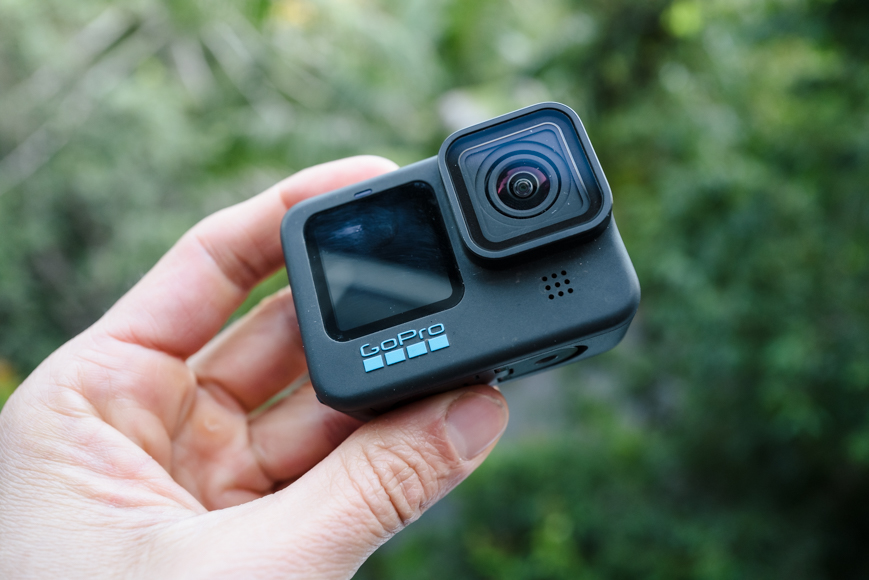
- 3K video
- Fast frame rates
- User-friendly
- Vertical video shooting
- Expensive
- No super-slo-mo at full-resolution
This is a rugged, portable slow-motion camera, which is also packed with features and exceptionally user-friendly.
At full resolution, you can shoot up to 60 fps, at 4K you can get 120 fps, and you can have 240 fps at 2.7K.
You can also shoot that slow-motion video vertically. The GoPro Hero 12 Black can shoot vertical video without needing to rotate the camera.
That’s a game-changer for social media content, as you don’t need to crop in to make vertical video and can therefore create and post full-resolution footage of that orientation.
Your footage can be shot in 10-bit color, and the camera contains pro-GP logs to help you unlock more dynamic range and colors during post-production.
Your slow-motion footage will be ultra-smooth, too. GoPro has outstanding image stabilization, Hypersmooth 6, plus Horizon Lock, which allows you to maintain a level horizon even when the camera rotates a full 360 degrees.
This nifty action camera comes with the Enduro battery rather than the standard GoPro battery, which is great news for anyone wanting to shoot slow-motion footage in extreme temperatures and/or for a long time.
This battery also gives you excellent run times, allowing 70 minutes of shooting at 5.3K at 60 fps, or 155 minutes at 30fps in 1080p.
You also get a host of other features for speeding up your footage, taking photos, and making time-lapses.
- Read more: Best Action Cameras of 2024
Chronos 2.1-HD (Best Entry-Level High Speed Camera)
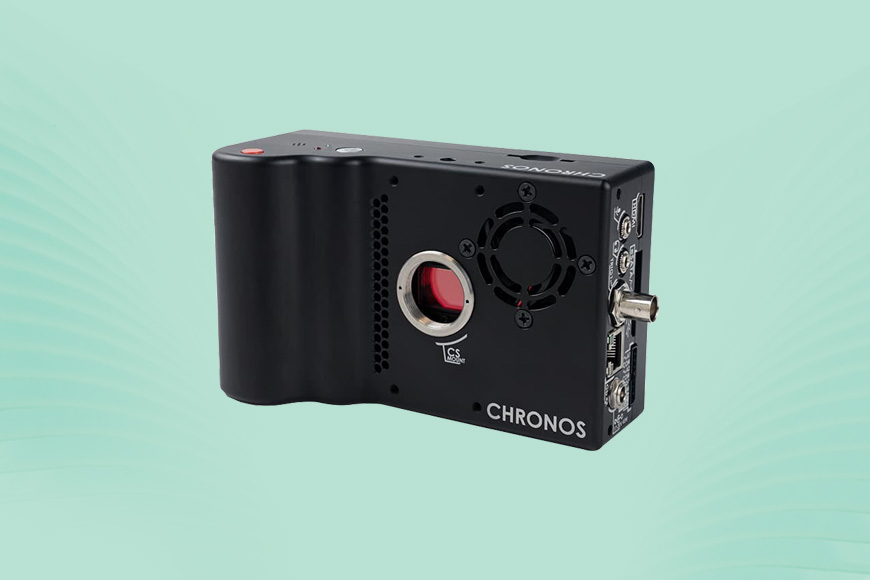
- Well-designed
- Touchscreen display
- Exceptionally high frame rate
- High ISO sensitivity
- Very expensive
- No 4K
The Chronos 2.1-HD is one of the best slow-motion cameras out there, and we included it as an option for serious slow-motion filmmakers or industry people who want a true, highly specialized, high-speed camera.
It costs between $7000 and $8000 (depending on specifications), and while that price may seem high, it’s the most affordable high-speed camera.
The better-known Phantom cameras, for example, can cost as much as $80,000, even for the company’s “entry-level” models.
It shoots in high-resolution HD at 1000 fps, and if you shoot at lower resolutions, you can get up to 24046 fps.
It’s portable, with an hour of battery life and a 5-inch touchscreen display from which you can access all the settings.
It has focus peaking to help you fine-tune your focus and is good in variable lighting conditions as it has native ISO of up to 8000 (in color) and 16000 (in monochrome).
The Chronos is also extremely versatile in the sense that if you already have Canon or Nikon lenses, you can use it with those.
What Kind of Camera Do You Need to Shoot Slow Motion Videos?
To shoot these kinds of videos, you need a camera that can record at high frame rates, typically 120 fps or higher.
The higher the speed, the smoother and more detailed the slowed-down footage.
Some cameras have a dedicated slow-motion mode, and others give you the option to adjust your frame rates.
The camera must have good low-light performance, too, as higher frame rates often require more light.
There are several options to choose from.
Many mirrorless cameras, like the Panasonic Lumix GH6, can record at high frame rates. The GH6 can record up to 120fps in 4K and 10-bit color.
Cameras like these strike a balance between video capabilities and portability, making them suitable for a range of videography needs.
They also come at a lower price point, making them affordable for video professionals and serious hobbyists.
On the other hand, high-speed cameras like the Chronos 2.1-HD are specialized tools designed specifically for capturing extremely high frame rates.
In the case of the Chronos, that’s 1000 fps at full resolution, and up to 24046 fps at low resolution.
These cameras are designed for situations where ultra-slow-motion detail is crucial, such as in scientific research or specialized cinematography.
They are bulkier, more complicated to use, and come with a much higher price tag.
What Is a Super Slow Motion Camera?
A super slow-motion camera is a specialized device designed to capture video at extremely high frame rates, which results in exceptionally smooth and detailed slowed-down footage.
Unlike standard video cameras that typically record at between 24 and 60 fps, super slow-motion cameras can achieve frame rates well beyond 1000 fps, and some models can even exceed 10,000 fps.
Super slow-motion cameras are particularly useful when precise analysis or artistic exploration of particular details is essential.
Scientific research, sports analysis, and cinematography are examples of fields that benefit from the ability to capture and study rapid movements, subtle details, or dramatic action.
These kinds of cameras are specialized equipment and made by manufacturers like Chronos and Vision Research.
What Is the Best Frame Rate for Shooting in Slow Motion?
Ultimately, your choice of frame rate is going to very much depend on what you need your footage for.
For example, 24 fps is the foundation you’ll normally start from, as that’s the traditional cinematic frame rate, which is ideal for narrative filmmaking and storytelling.
There’s also 30fps, which is commonly used in television and online video content, as it has a slightly smoother look.
60 fps is where you start getting into slow-motion footage. It’s slow, but not too slow; you still get a sense of the real-time motion.
It’s often used for capturing fast-paced action scenes or sports in slow motion.
When you get to 120 fps and above, you’re in the realm of dramatic cinematic sequences or creative video looks.
The effects at this speed are pronounced, so it’s normally used to capture detailed, intricate movements.
At 240 fps and higher, things get quite extreme. This kind of speed is often used in specialized cinematography or the sciences, and it’s only needed if you want to slow down very fast movements.
Other than what you will need your footage for and how you’d like it to look, you should consider where it will be viewed and your post-production process when choosing a frame rate.
Online platforms commonly support 24fps and 30fps playback, while higher frame rates might need you to use specific viewing environments.
Higher frame rates also give you more flexibility in post-production. They allow you to significantly slow down footage without losing quality, providing room for creative adjustments.
So, it may sometimes be worth you shooting in slow motion to begin with.
How Do You Make a Camera Shoot in Slow Motion?
Making a camera shoot in slow motion involves adjusting its frame rate, which is the number of images it captures per second.
Here’s a step-by-step guide:
Access the Menu Settings
Navigate to your camera’s menu and locate the video settings. Look for options related to frame rate or slow-motion recording.
Choose a High Frame Rate
Select a higher frame rate for slow-motion footage. Common frame rates include 60fps, 120fps, 240fps, or even higher. The higher the frame rate, the smoother the effect.
Adjust Resolution
This is an optional step, but some cameras might need you to lower the resolution when shooting at higher frame rates.
Be mindful of this as it can impact video quality.
Set Shutter Speed and Aperture
Adjust other video settings like shutter speed and aperture to ensure proper exposure.
In some cases, especially when using very high frame rates, shooting in a naturally bright environment or with additional lighting might be necessary.
Start Recording
Once your settings are configured, start recording.
When you play back the footage, you’ll notice the effect created by the increased frame rate.
Please note that, although this is a general guide, your camera may have specific steps that aren’t mentioned here. Have a look in your manual if you get stuck.
Also, although this is primarily a guide for cameras, but you can also use an app to do the same thing on your phone.
What Are the Best Slow Motion Camera Apps?
While we’ve been mainly concerned with covering videography tools and dedicated slow-motion cameras, several apps can help you do the same on your smartphone.
FiLMiC Pro (iOS/Android)
This is an absolute beast of an app – a professional-grade piece of video recording software that includes slow-motion functionality.
It has an extremely user-friendly interface that gives you easy access to its whole suite of manual controls.
You get variable frame rates, which means that creating super-slow footage is a breeze.
It also has image stabilization, log and flat color profiles, manual focus pulling, and audio monitoring.
SloPro (iOS)
SloPro is a user-friendly app designed simply for creating slow-motion videos.
It offers adjustable speed controls, allowing you to slow down specific segments of your footage while maintaining standard speed in other parts.
As everything is automated, you can’t choose your specific frame rate, though – just between ‘slow’, ‘slower’, and ‘slowest’.
But for anyone who wants a quick and easy way to get super-slow footage and also share it on social media, this could be it.
Slow Fast Slow (iOS)
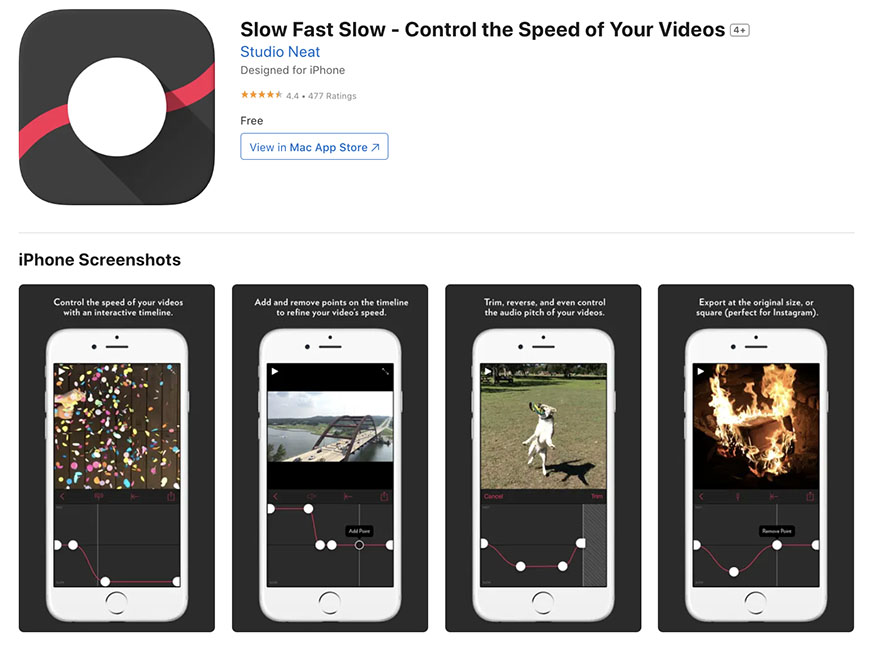
Credit: App Store
This hidden gem of a free app lives up to its name by offering intuitive controls for adjusting the speed of your videos.
With it, you can create seamless transitions between regular and slowed-down segments in your recordings.
The interface is super easy to use, with an interactive timeline where you can not only make those speed adjustments but also fine-tune the audio.
It also has several export options for different types of social media.
Efectum (iOS/Android)
Efectum is a versatile and powerful app that not only facilitates slow-motion recording with its range of speed control options but also includes features for reverse video and fast motion.
There’s also a time-lapse setting, and you can add audio, and share directly to social media platforms.
Slow Motion Video FX (Android)
This is another user-friendly app that allows you to easily create slowed-down videos.
From the interactive timeline, you can adjust the speed of the footage (or just adjust some parts of it) and slow it right down.
You can also add filters and special effects, add music, and share straight to social media.
FAQs About Slow Motion Cameras
What is the best video camera for sports slow motion?
If you’re using an app, I’d recommend Filmic, as it has the pro-level features you’d need to freeze sports action.
Otherwise, the best slow-motion cameras would be one of our top two picks, the Panasonic Lumix GH6, or the Sony Alpha 7S II.
How expensive is a slow motion camera?
It depends on your needs.
You can find a slow-motion camera with good specs for under $1000.
But, if you’re looking for specialist equipment, you could pay $100,000 or more.
How much is a Phantom slow motion camera?
Phantom Series slow-motion cameras are highly specialized pieces of equipment for use in ballistics and different fields of engineering and science.
They are extremely expensive. Their ‘entry-level’ product, the TMX 7510, retails for over $70,000.
What is the fastest slow motion camera?
Out of the ones in this guide, the Chronos is the fastest slow-motion camera, as it shoots at frame rates of 1000 fps and higher.
The TMX 7510 mentioned above shoots 76,000 fps in HD.
Is it better to shoot slow motion in 4k or HD?
4K is high-resolution, so any slowed-down footage you create in that mode will be high-quality.
However, many cameras don’t offer their highest frame rates per second in 4K. You might have to drop down to HD mode to get those super-slow frame rates.
The choice is a balance between whether you need the highest quality footage or the slowest footage.
What camera can shoot at 1000fps?
Any dedicated slow-motion camera can shoot at that speed (normally at full resolution), and even higher at lower resolutions.
The Chronos 2.1-HD can shoot at 1000 fps, and so can many other dedicated slow-motion cameras.
What is the most expensive slow motion camera?
Out of the cameras in this guide, the Chronos 2.1-HD is the most expensive, at around $8000.
But the higher-end Phantom Series camera from Vision Tech can cost around $100,000.
Does Android camera have slow motion?
An Android device can shoot slow-motion footage if you use an app with that functionality.
You could use Slow Motion Video FX, Efectum, or, if you want to go deep into manual controls, Filmic Pro.






